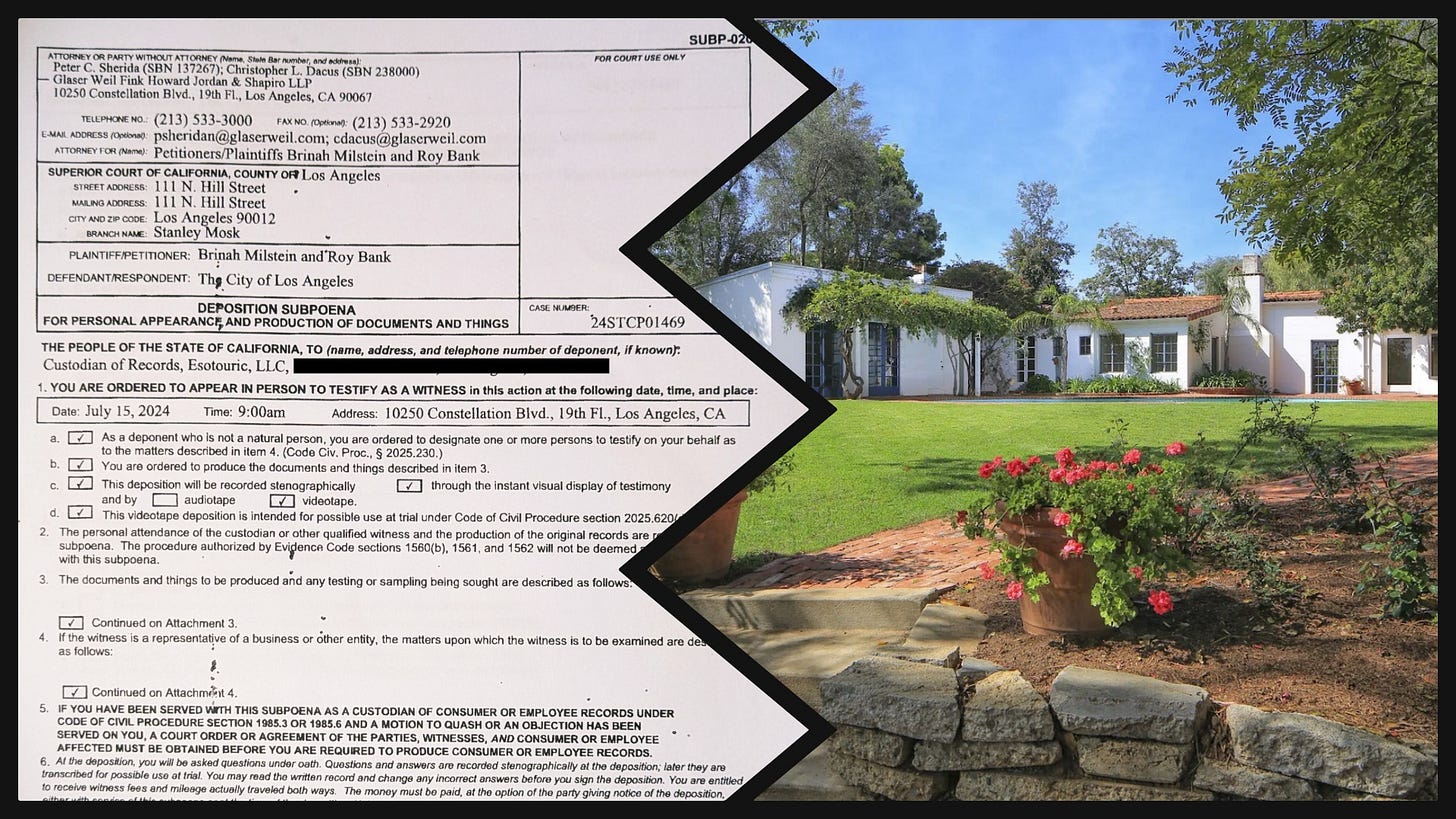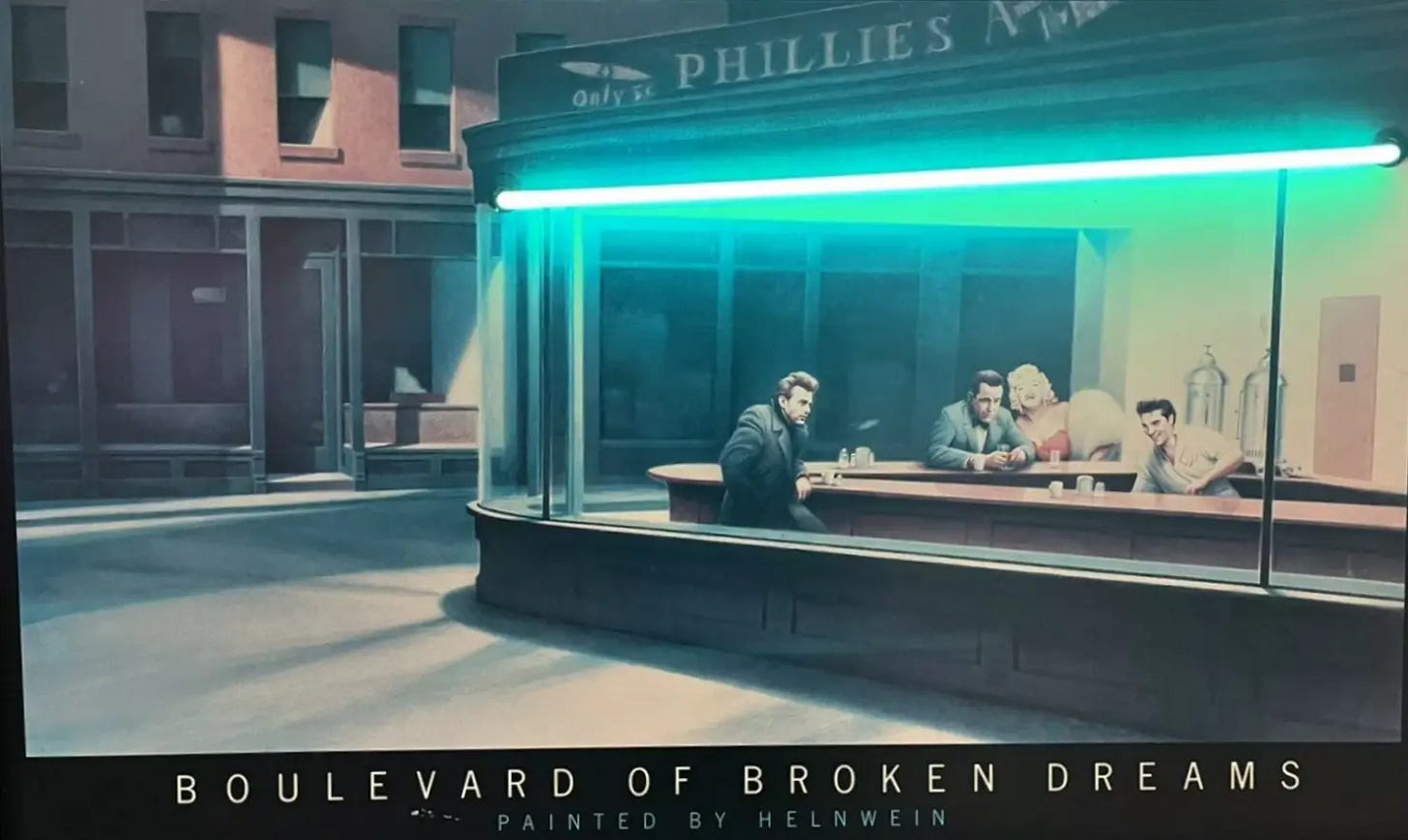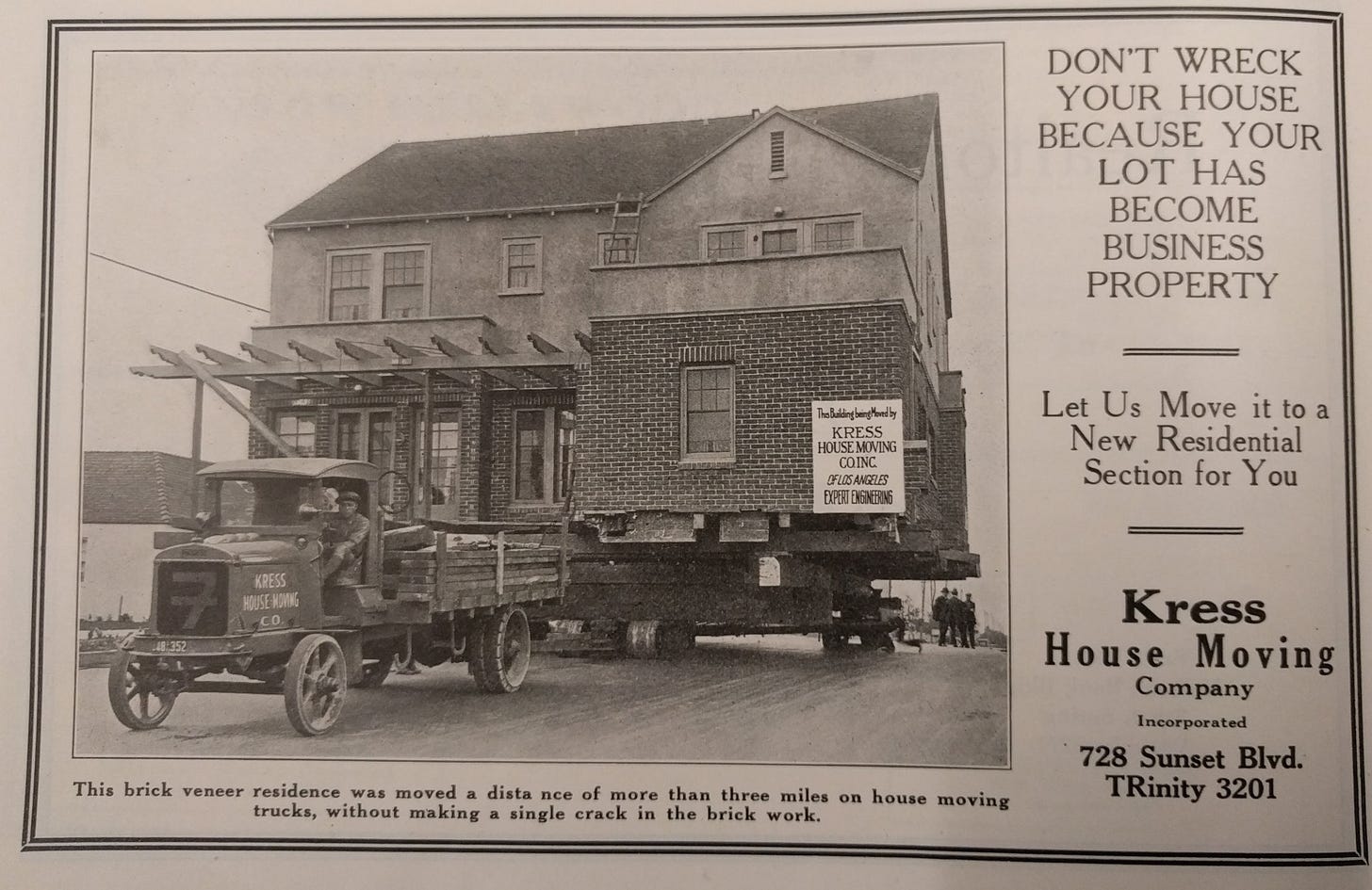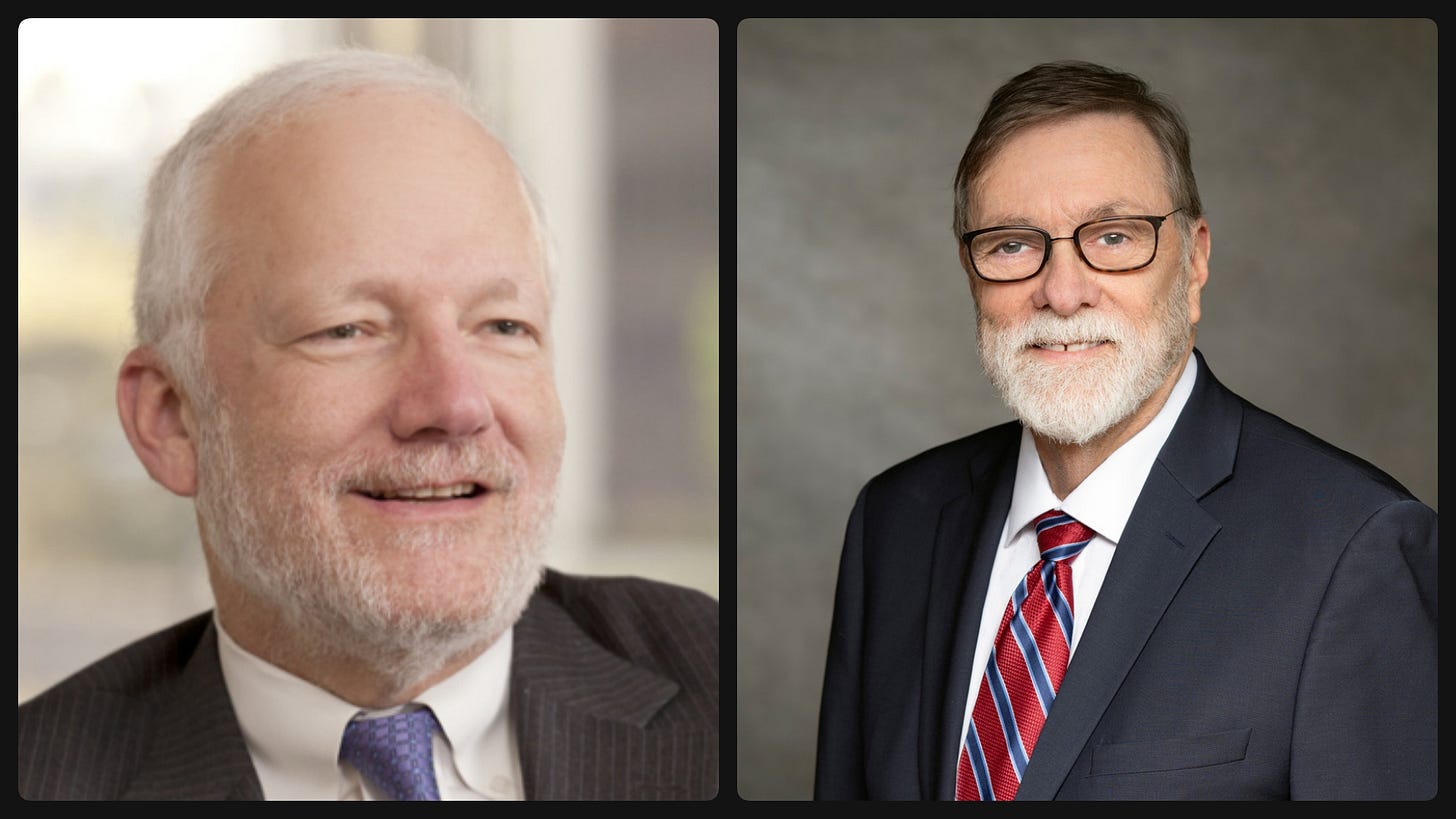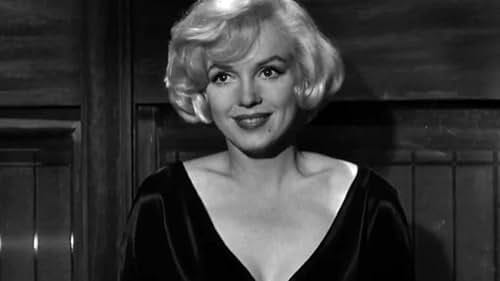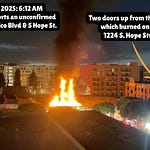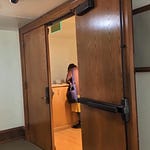Gentle reader,
Have you wondered why you haven’t heard about Marilyn Monroe’s house lately?
It’s not because there is no news about the recently landmarked property.
(New: for the TLDR short version of this post, click here.)
In the case of our ongoing reporting, of which this is the 9th dispatch, the silence is because we were inhibited after a process server knocked on our door in early June with a subpoena demanding we turn over records and appear for a deposition as a third party witness in the court case Brinah Milstein, Et Al. Vs The City Of Los Angeles (24STCP01469).
And we’re not alone: our understanding from the legal record, court appearances, public records requests and personal discussions is that numerous other private citizens, preservation non-profits and City staff also were subpoenaed prior to the final landmark vote.
This activity has diverted professional resources and created a chilling effect on saying much of anything about the house where Marilyn Monroe lived and died.
We’ve been monitoring the petition for writ of mandate, which seeks to void the landmark vote and restore the property owners’ demolition permits, by obtaining legal filings and attending trial setting hearings at Stanley Mosk Courthouse in Los Angeles.
But we have not been reporting on any of this in real time—not until the shadow of this stressful, time consuming and expensive subpoena and deposition was behind us.
Well, it is… and we’re back! And it’s going to be a long post, going deep into previously unreported aspects of the Marilyn Monroe house landmarking story: community group and political donor ethical questions, intimidation of preservationists, a truly unhinged “public” records disclosure and spaghetti-meets-wall legal strategies.
But before we bring you up to speed on where things stand with the serious, ongoing efforts to undo the preservation of Marilyn’s house, we need to ask for your support.
If you are able, please help us with the legal expenses incurred and the days it took to organize and turn over about 12,000 pages of documents responsive to an extremely broad request, which included all of our research and reporting.
Receiving this subpoena was, frankly, a gross experience. We felt our privacy was invaded, it was intimidating (the law firm has a heavy history that was familiar to us as true crime historians), it negatively impacted our ability to communicate freely with preservation pals and with our readers, and made it harder to do advocacy work, since we were drowning in administrative demands made under the threat of being held in contempt of court.
Also, document production is incredibly tedious, unpaid labor. Blech!
So here’s the ask: if you value our journalism and our historic preservation and tenant advocacy looking out for Los Angeles, will you please chip in?
Ways to help include subscribing to the paid version of this newsletter, buying a ticket for an upcoming walking tour, surprising somebody with a gift certificate or booking a private tour. You can also sign up for the streaming webinar channel, pick up a copy of Kim’s 1920s mystery novel or something else from the souvenir shop, or tip us on Venmo (Esotouric) or here.
And if you’re planning for the holidays or just want to treat yourself, we’ve created a special offer: 10 walking tour tickets for the price of 8, to use by yourself or with friends, or to give as gifts. We can make gift certificates for single tickets or any combination. [This offer is no longer active, but you can still support us by buying gift certificates, and we appreciate it!]
If you’re not in a position to contribute financially, then please share this newsletter with others who care. And know that we are grateful for your support and good wishes, and that we do this work for you.
Now back to the Marilyn Monroe house saga, which we left off on June 27, 2024 with this report from City Hall chambers and the final vote to determine if 12305 Fifth Helena Drive would be declared a protected city landmark.
Even on what should have been a day of celebration, we were stressing about that subpoena. But we wouldn’t have missed the vote for anything. The house, and the process of public review before a potential landmark gets demolished, matter.
When Richard sent his September 6, 2023 email to the office of councilmember Traci Park, alerting planning staff to the pending demolition of Marilyn’s house—apparently about to happen without the required 30 days public notice—and asking for a conversation about a council-initiated nomination to re-set the clock, he was exercising his Constitutional right as a citizen to petition for redress of grievances to an elected representative.
Esotouric is the voice of citizen preservation advocacy and good land use policy in Los Angeles. It would have been weird if we hadn’t gotten involved.
Lack of proper demolition notice posting threatens historic rent stabilized apartments and bungalow courts and legacy businesses. Now it seemed as if it might be about to happen to one of the most famous houses in the world—and this time, the whole world was watching. (We had the honor of serving as expert sources for the reporting of the New York Times and Times of London as this nomination worked its way through the system.)
Richard’s email to Traci Park’s planning staff was turned over to the property owners’ attorneys at Glaser Weil Fink Howard Jordan & Shapiro LLP in response to a public records request, and branded Exhibit E, which the attorneys miscategorized as the selfish request of a “mercenary” “for-profit” tour operator.
Richard’s email was slotted it into a bizarre conspiracy theory, alleging that the City moved to initiate a bogus landmark designation, in part, so that our tour company could benefit.
However, there’s no evidence that the City’s determination was illegitimate. And we don’t give tours in West L.A., nor do we give tours about famous movie stars or their houses.

The allegation that members of the preservation community are in some kind of corrupt cahoots with the branch of the City that prepares landmark designations is not unique: in 2021, similar claims were made by Benjamin M. Reznik and Daniel F. Freedman of Jeffer Mangels Butler & Mitchell LLP, attorneys for property owner Arthur Jafa Fielder. Maybe Glaser Weil heard the idea down at the local coffee shop. Reznik and Freedman alleged bias in favor of the Los Angeles Conservancy by City Planning staff and the Cultural Heritage Commission around the proposed landmarking of the Kurt Cobain / Philip Ahn residence in the Hollywood Hills. See page 40 here; that house never advanced to a landmark vote.
People can sue anyone for anything in the state of California, and make all kinds of arguments when doing so. Proving them in court is another matter, as is convincing a judge that something you don’t like is actionable. More on what’s been happening in court below.
But first, let’s flash back to March 3, 2024, 116 days before the landmark vote, and the video embedded at the top of this post. What’s up with that? Buckle up…
Shout out to preservation pal Mike Callahan, author of the essential land use shenanigans newsletter The Dusty Archive, for alerting us to the video from a special Zoom meeting the Brentwood Community Council held to discuss sending a letter opposing landmark status for Marilyn’s house to City Council’s PLUM Committee ahead of its March 5, 2024 vote.
We’ve chosen to host this video because, while the BCC functions somewhat like a Neighborhood Council and is generally recognized as its equivalent by the City, it is a private organization not subject to the Brown Act. They could if they wanted to take this video offline at any time. We’ve added embedded captions to make the conversation easier to follow.
It is also a newsworthy community meeting, as it includes a six-minute presentation by property owners Brinah Milstein and Roy Bank. They explain all the reasons why they oppose landmark designation and are asking for a letter to be sent by BCC to the PLUM Committee. Skip ahead to 37:16 to hear what they have to say.
While we didn’t watch the embedded meeting live, we did virtually attend the September 12, 2023 Land Use Committee meeting, when members discussed the proposed demolition, for which they had not received the required notification. That one seemed to be a fairly standard community meeting. The only odd thing was that our raised hand was ignored when we tried to give public comment.
The March 3, 2024 special meeting also seems fairly standard. After about an hour of respectful discussion among dues paying BCC board members, those in attendance voted to send the requested letter of opposition, which was duly posted to the case file. PLUM then voted in favor, and sent the nomination on to full City Council.
As we reported in our second Marilyn dispatch, BCC’s letter included an attachment from corporate branding entity Authentic, which controls the Marilyn Monroe Estate and is co-owner of Elvis Presley’s Graceland.
Authentic wrote that they had been working with Milstein-Bank to try to physically move the house, restore it, and reopen it by Marilyn’s 2026 centennial as a tourist attraction. This previously unreported proposal was discussed during the meeting, along with the claim from the property owners that should the house get landmarked, it would be “impossible” to move afterwards.
Brinah Milstein: If it does become designated, it will be impossible to move. It will be possibly millions of dollars in the—
Roy Bank: CEQA—
Brinah Milstein: Environmental Impact Report. And then the Cultural Heritage [Commission] has to approve the site and then people can oppose where it's going to be moved to. And this could be decades of living with this!
Roy Bank: All the stuff that, you know, we're all so familiar with the Munger [Barry] Building [the beloved former Dutton’s Brentwood Books home, boarded up for years and currently threatened with demolition for no new project] because we pass it every single day, all the stuff that that building needs to do just to tear it down is a similar process for us to move it once it's historic. If we can, you know, work with Traci [Park’s] office, hopefully, and not designate, then moving it becomes a real realistic thing that we're more than happy to do because it's a win-win.
Well, not necessarily. Los Angeles landmarks can and have been moved before.
And we might have offered a preservationist’s informed perspective on this topic, but we weren’t informed about this meeting—and even if we had tuned in, likely would not have been called on, since we are not dues paying members of this private group which play acts as being a Neighborhood Council. Which it is not!
At the time of this meeting, Milstein-Bank were represented in their discussions with the City by attorneys George J. Mihlsten of Latham and Watkins and William Delvac of Armbruster Goldsmith & Delvac.
George and Bill are a couple of land use heavy hitters. Delvac has particular cultural heritage expertise, as he was central to the Los Angeles Conservancy’s efforts to preserve and repurpose St. Vibiana’s Cathedral and co-authored A Preservationist's Guide to CEQA and Affordable Housing Through Historic Preservation: A Case Study Guide to Combining the Tax Credits, before switching sides to work with developers seeking to demolish or alter historic structures.
While we often find ourselves on opposite sides of an issue, Bill Delvac is a gentleman who is always open to discussion and compromise, so we were hopeful that a good solution could be reached.
But by May 6, 2024, when Milstein-Bank filed their petition for writ of mandate seeking a temporary restraining order, which you can read below along with the supplemental declaration of property owner Roy Bank, Delvac and Mihlsten were out of the picture.
Milstein-Bank’s new public spokesman was Peter C. Sheridan, a partner with Glaser Weil Fink Howard Jordan & Shapiro LLP. George Milhlsten’s Latham and Watkins colleague, Benjamin Hanelin, lead attorney on the recent B’nai B’rith Lodge demolition was now on the case, as well.
Peter Sheridan immediately started making media statements about the “profiteering” tour operators who were in on the City’s supposedly bogus landmark efforts.
You know who else is a partner with Glaser Weil Fink Howard Jordan & Shapiro LLP? Carolyn Jordan, chair of the Brentwood Community Council.
Yep, the same neighborhood group that formally opposed landmarking in a letter to elected officials—just weeks before her law firm filed suit against the City and began slapping everyone peripherally associated with the preservation effort with subpoenas for third party discovery!
In 2019, in a story titled “Brentwood’s Dirty Little Secret,” CityWatch expressed alarm about the Brentwood Community Council’s biased, undemocratic activity and lack of transparency, observing that Carolyn Jordan was running the Land Use Committee while representing legal clients who came before the BCC.
And in 2021 Knock LA—a source that has ethical issues of its own—published a lengthy story based on leaked documents, tying BCC into decades of corrupt misuse of Westwood VA land that was gifted in perpetuity as housing for needy service members, a state of affairs recently halted by judicial order.
(Parenthetically, you might have heard of the Brentwood Community Council if you follow homelessness policy on the nation level: BCC in September 2019 filed an amicus curiae (“friend of the court”) brief with the U.S. Supreme Court in connection with the City of Boise’s appeal over the right to rest on public land. Jordan’s law firm filed that brief, too.)
But because Brentwood Community Council isn’t a certified Neighborhood Council, not subject to the Brown Act nor operating at the pleasure of the Department of Neighborhood Empowerment, there’s nothing the City or citizens can do about them.
Yet in January, just one day after the Cultural Heritage Commission voted in favor of landmarking Marilyn’s house, nominating Councilmember Traci Park introduced a motion seeking to grant private community groups like BCC the same rights and privileges as certified Neighborhood Councils.
This proposal has generated numerous collectively approved statements of opposition from actual Neighborhood Councils, including this red hot objection from Palms, which warns that such a change in policy “would mark the end of the Neighborhood Council system as we know it.”
It seems remarkable to us that BCC’s Carolyn Jordan was quoted in the New York Times in September 2023, affirming that her organization never received the required advance demolition notification and expressing the personal opinion that Marilyn’s house ought to be preserved, then ran a meeting in March 2024 advocating for the house not to be protected.
Add in Jordan’s law firm subsequently filing a writ and (we believe) serving subpoenas on private citizens, preservation nonprofits and City staffers, and it’s a strong argument that pay-to-play community groups like BCC are not the same as Neighborhood Councils, and should not be afforded the same rights and privileges.
Note, too, that while Glaser Weil’s first amended petition for writ of mandate alleges councilmember Traci Park “had an unacceptable probability of bias” in favor of the landmark designation (see pages 6-7), a search of the Los Angeles City Ethics portal shows that Park and her 2022 election committee received nearly $20,000 in campaign contributions from people employed by Glaser Weil, including Milstein-Bank’s attorney Peter C. Sheridan ($900), Carolyn Jordan ($6400) and her husband Daniel Jordan ($3400), all of them partners in the firm.
Carolyn Jordan ($1000) and Glaser Weil founding partner Patricia Glaser ($3000) also donated help elect City Attorney Hydee Feldstein Soto, whose deputies are representing the City in the petition for writ of mandate.
We believe that the roles of the Brentwood Community Council and the firm of Glaser Weil in the possible court ordered reversal of the landmark designation of Marilyn Monroe’s house are significant, and should be further reported on.
Now let’s get you up to speed on Milstein Vs. City of Los Angeles.
While there have been several preliminary hearings, the record is not yet certified and no trial date has been set. We have been the only journalists in the courtroom for these hearings, observing the nuanced exchanges that are only hinted at in Judge James. C. Chalfant’s terse minute orders. Read on for an overview of what’s been happening and where the case currently stands.
JUNE 4, 2024 - MOTION FOR ISSUANCE OF A PRELIMINARY INJUNCTION
An especially dramatic hearing, held 23 days before City Council’s vote, on Milstein-Bank’s motion for issuance of a preliminary injunction, which you can read below.
We were starting to write about this hearing when the process server knocked, and made the difficult decision to stop reporting for our own protection.
We’re just two people, doing what we do because we care about Los Angeles. We don’t have the resources of a newsroom’s legal team or editorial support. So while we were the journalists most familiar with the cultural heritage ordinance and the personalities involved in this landmarking effort, which is why major outlets like the New York Times and Times of London sought our insight, we stopped writing about it.
We’re sorry we had to do that, for your sake and for ours. Intimidation of reporters through legal means is real and scary.
We believe that the mainstream media must assign investigative reporters to the land use beat. After all, it was Hollywood preservation, tenants’ rights and public safety activists who called out systemic real estate corruption in City Hall years before the Feds arrested councilmember Jose Huizar and Deputy Mayor Raymond Chan, both men since convicted on public corruption charges.
Imagine how much better things would be, if those crooks had been stopped in 2013!
The June 4 hearing before Judge Chalfant was a last ditch attempt, after the property owners and City had mutually agreed to more time before the matter was voted on, to have the judge halt the landmarking process.
The injunction motion also served as a preview of some of the arguments Peter C. Sheridan intended to make when arguing the writ of mandate —a literal “trial balloon” that was so poorly received it resulted in a major shift in the focus of the case.
Prior to the hearing, Judge Chalfant issued his tentative ruling, siding with the City so that the democratic process of holding a vote could happen. The ruling is a good overview of the claims made and the case law that applies, and you can read it below.
But the ruling was not final, and the few of us in Department #85 that morning got quite a show before, as expected, the judge denied the injunction. Property owner Roy Bank was in the courtroom to observe, along with a private court reporter who had a real Stevie Nicks circa 1976 vibe going on.
The hearing began on a bad foot for Milstein-Bank, when Ms. Nicks interrupted the soft spoken judge to say she was having trouble hearing him, and he let her know that he didn’t appreciate that.
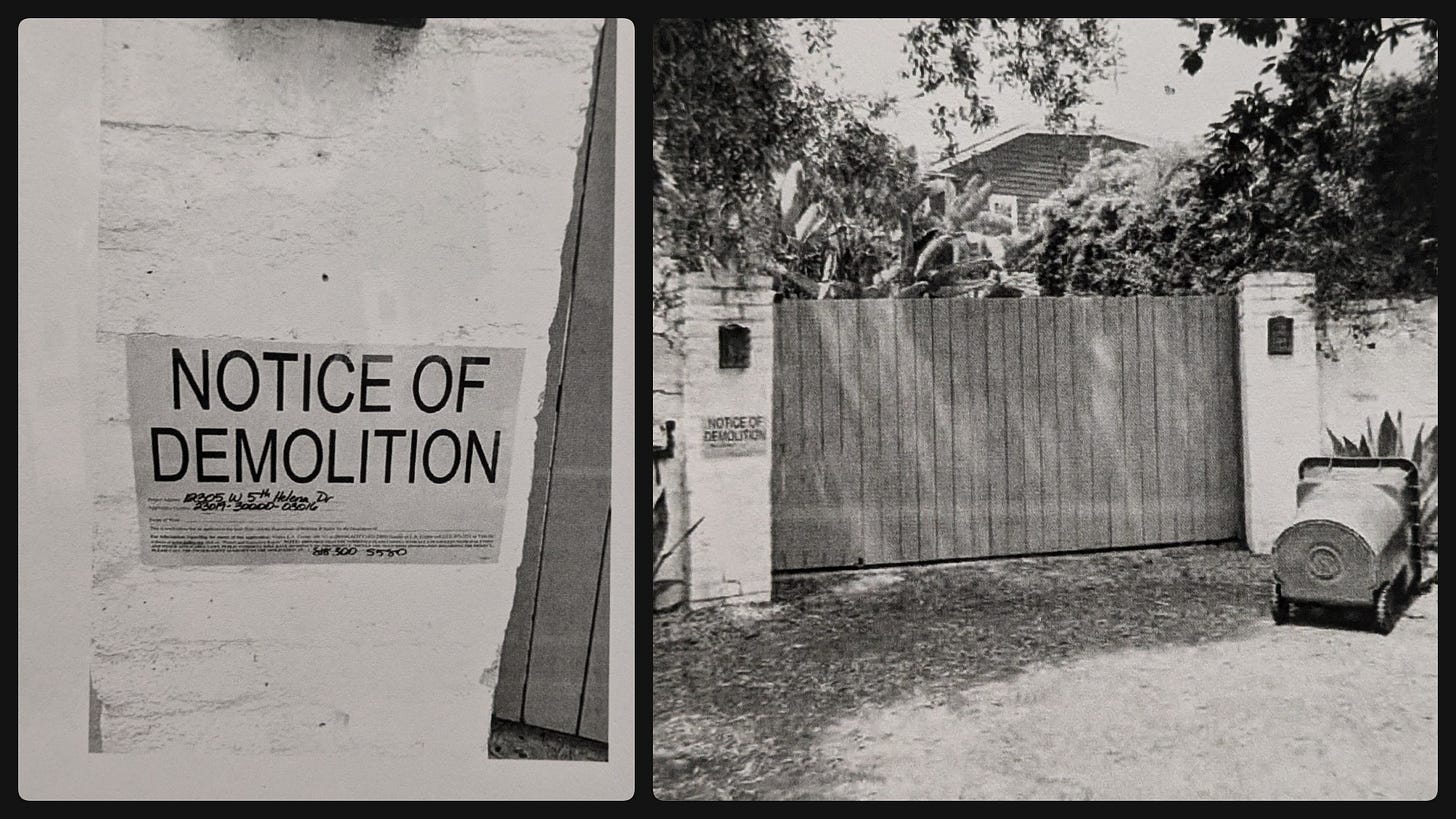
Arguing that the right to demolish a building was vested, and because there had been no objections during the 30 day posting period—during which no citizen reported seeing a sign and the Brentwood Community Council was not notified—the permits should be restored, Sheridan seemed to be unclear on how the cultural heritage ordinance is enshrined in Los Angeles municipal code and how it functions. It is possible that this was a strategic choice, to undermine preservation generally as well as this particular instance.
Judge Chalfant, who handles a lot of cultural heritage cases, seemed annoyed.
Sheridan objected to the Department of City Planning having been directed to prepare the nomination, as if unaware that Office of Historic Resources is part of that department.
He mistakenly asserted that the volunteer Cultural Heritage Commissioners should have done this research, apparently based on a misreading of the phrase “submit its report” in the councilmember’s motion. (The CHC reads applications prepared by others, listens to presentations and public comment, tours potential landmarks and discusses them, and occasionally they direct staff to prepare a landmark application. They then produce a report incorporating the application, staff recommendation and their vote.)

Sheridan alleged it was somehow corrupt that councilmember Traci Park, on initiating the landmark nomination in response to massive public outcry, had expressed her personal opinion that it was worthwhile.
And he suggested that private citizen and then Hollywood Heritage board member Heather Goers ought not to have volunteered to prepare the application.
But neither of these acts is unlawful, illegal or uncommon.
Judge Chalfant summarized and rejected most of Sheridan’s case, with his reasoning always coming back to it being in the public interest that the landmark process not be halted, and that Milstein-Bank would suffer no irreversible harm from waiting to see how that vote played out. (The deadline was, at the time of this hearing, June 16, 2024. The City would subsequently extend it until June 27, 2024, when City Council finally voted.)
Sheridan asserted his clients had no intention of actually using their demolition permits if restored, but simply wanted to halt the landmarking process until their case could be heard.
The judge was skeptical, observing that nothing in their filing said the house would be safe pending a court decision. But if Sheridan affirmed they would not demolish, he’d take his prediction that “a preliminary injunction and resultant destruction of the home may increase public attention to the Property and to Petitioners” out of his ruling.
Deputy City Attorney K. Lucy Atwood countered that should City Council fail to act by the deadline, the stay on demolition would lapse and the house could be torn down.
Sheridan then suggested the house being difficult to see from the street made it unique, and if it should be designated, it would be the first City landmark that was impossible to see from the public right of way without trespassing.
But in fact, many landmarks are invisible from the public right of way, located up private driveways, in gated communities or hidden behind walls, hedges and gates.
Examples of landmarks that cannot easily be seen from the public right of way include The Doheny Residence inside the gated Mount Saint Mary’s University campus (HCM #30), The Dutch Chocolate Shop tile in the shuttered Finney’s Cafeteria (HCM #137), Harold Lloyd’s Greenacres (HCM #279) and the C.E. Toberman Estate below Runyon Canyon (HCM #285), and these are just a sampling from monuments added to the City’s registry prior to 1985.

The judge acknowledged that there was some harm in looky-loos peeping over the fence, but reminded Sheridan that his clients had purchased Marilyn Monroe’s house.
The judge repeated that he saw no irreparable harm in waiting to see how the City voted. They had waited seven months to petition—what was another 12 days?
Sheridan explained that the matter had first to go through the Cultural Heritage Commission and PLUM, but while that was happening, efforts were being made to convince the City to “reconsider what it was doing, including relocating the house.”
And here Judge Chalfant raised his voice. “You knew all these facts in September and October!”
Why wait so long? Perhaps the delay was because in September and October 2023, Glaser Weil was not representing Milstein-Bank. By May 2024 they were, and legal action soon followed.
And suddenly, we understood why we were sitting in a courtroom on a Tuesday morning to watch a judge make hash of Peter Sheridan’s case.
Fitzgerald observed, 'Let me tell you about the very rich. They are different from you and me.” Which is to say, for some people, rules almost never apply, and when they do, it feels like the end of the world.
The property owners may have believed that the house wouldn’t receive a landmark designation so long as they were using their considerable resources trying to ensure that it was physically moved to a new location. Perhaps they only filed an injunction and request for a temporary restraining order once it became clear that the process was moving forward to meet the voting deadline required under the City Charter.
Chalfant and Sheridan argued about precedents and cases not mentioned in the filing, if the councilmember might recuse herself, and the delay in letting the Cultural Heritage Commissioners in to tour the house. It was heated and lightning fast.
Matthew Meehan from the City Attorney’s office chimed in that these were all matters to bring up in a trial, not a preliminary injunction.
Would Judge Chalfant go for it? He would not—which is good, because if unhappy property owners could just go to court to stop the work of elected and appointed officials, the City couldn’t function.
Observing that Sheridan’s arguments were not “adequately teed up for a preliminary injunction,” Chalfant scheduled a trial setting conference for August 13, 2024, should the landmark be designated. If City Council voted no, the matter would be moot. But they voted yes, and so 70 days later, we attended…
AUGUST 13, 2024 - TRIAL SETTING CONFERENCE #1 / AMENDED PETITION
When we returned to the courthouse on August 13, 2024 for a seven minute long trial setting conference, we also stopped by the mezzanine terminal to read the latest filing, the First Amended Petition for Writ of Mandate. Due to the slow resumption of services after the courthouse ransomware attack, it was not present on the docket for free review, so we had to buy a printed copy (80 bucks!). We’ve uploaded it below for your review.
The amended petition supersedes the original filing, removes mention of halting the vote which had now happened, and includes some new information and claims.
Most significantly, there is now a Sixth Cause of Action (pages 38-40) alleging that the City violated the California Environmental Quality Act (CEQA) by failing to conduct an environmental review prior to the historic designation.
A CEQA challenge by its nature is a wonky argument between property owners or community members and the City, which renders the allegations against private citizens and preservation nonprofits irrelevant. And indeed, in court after the formal proceedings had concluded, Judge Chalfant asked explicitly if this was now a CEQA case, and attorney Peter C. Sheridan affirmed that it was.
And this time, Sheridan cited England v. Medical Examiners, 375 U.S. 411 (1964), a Supreme Court case in which chiropractors leap frogged out of Louisiana state court to seek relief from a higher court—suggesting that if the case didn’t go their way, Milstein-Bank were prepared to fight elsewhere.
On page 40, §169 in the amended petition, Sheridan suggests there might be a class of aggrieved property owners whose buildings had been designated against their wishes by elected officials, and that this aspect of the cultural heritage ordinance was unconstitutional.
And in fact, at the time of this filing, a second councilmember initiated landmark designation vote for a multi-million dollar Westside property was pending for the Rosalind (Roz) Wyman Residence at 10430 West Bellagio Road. As in the Marilyn case, City and property owner agreed to a delay, while the politically connected law firm DLA Piper negotiated on behalf of the new owners and the Wyman family. Then as the motion moved forward, only three of five PLUM Committee members showed up to vote on August 6, 2024 and councilmember Imelda Padilla made a rare no vote, effectively dooming her colleague Katy Yaroslavsky’s nomination. It expired without a final vote on October 2, 2024.
The formal court proceedings for Marilyn were brief. Sheridan stated that third party discovery was wrapping up—our deposition and document production was still to come—and the City was still providing emails. He was eager to set a trial date, but the Judge was unwilling to do so until the record was ready, date stamped and certified.
Calendars were opened to find a date for the next trial setting conference that worked for all, and Chalfant firmly advised that the case record had better be ready by then.
Spoiler: it was not ready.
SEPTEMBER 12, 2024 - TRIAL SETTING CONFERENCE #2
This hearing was brief, but memorable. Peter C. Sheridan stated that they only just turned over their index to the City Attorney, which meant the administrative record was still not complete. All third party discovery—yes, that includes us!—had ended the prior week.
Sheridan then stated he would respond to interrogatories provided by the City. The judge noted that he did not like interrogatories for mandamus.
At this, Peter Sheridan tensed up and was briefly unable to respond in a full sentence. He also bristled noticeably when Deputy City Attorney Matthew Meehan suggested the Petitioners may be deposed.
But it seems as if everyone else involved, peripherally or directly, has had to sit for a deposition, so why should it be any different for the property owners who started the whole thing? Their side of the story is important, and the Judge, City and community need to hear it straight from the source.
OCTOBER 3, 2024 - TRIAL SETTING CONFERENCE #3
We were again the only observers as Deputy City Attorney Matthew Meehan and Peter C. Sheridan from Glaser Weil provided updates to Judge Chalfant.
Sheridan said the certification of the record had still not been completed, but now that the City had filled the public records requests, he expected that to happen within days. Discovery had been received a few days ago, including what he categorized as “26 incredibly broad requests,” seeking every possible document his clients might possess over the last year. There would be “considerable dispute” about this.
The judge ordered Sheridan and the City to “meet and confer, in person, in a spirit of compromise. No blanket positions may be taken—discuss each request one by one.”
Again, Sheridan said he hoped to set a trial date now, or in early November after the meet and confer session.
Chalfant ordered the parties to return on November 5 for a fourth trial setting conference.
Matthew Meehan clarified that each of the discovery requests “was based on allegations in the petition.”
As for the delayed certification of the record, Sheridan knew that the City Attorney’s paralegal would be out of the office, and they could use more time—say until November 15?
Nope, they needed to get everything in by the next conference, and there would be no trial date until that happened, so hop to it. As we left the courtroom, the two attorneys were already discussing when and where they’d meet.
THE CASE OF THE “PUBLIC” RECORDS THAT SHOULD BE PRIVATE
That’s all for the court case to date. We’ll wrap up this extended Marilyn update with a disturbing set of “public” records which we received from the City.
In both versions of the property owners’ petition for writ of mandate, allegations of wrongdoing are made against Heather Goers, a private citizen who the Los Angeles Conservancy brought to the City’s Office of Historic Resources with an offer to prepare the Council initiated monument application.
It’s not unheard of for people who don’t work for the City to prepare one of these documents. The application is subject to editorial review by City staff, and when it’s completed staff prepares a recommendation for the Cultural Heritage Commission based on how convincing they found the argument.
In the first amended petition for writ of mandate filed on August 8, 2024, the property owners made a remarkable allegation: that Linda Dishman, then head of the Los Angeles Conservancy, “arranged” City employment for Heather Goers as “quid pro quo” in return for her volunteer nomination work.
Based on our knowledge of the City’s glacially paced hiring process, this allegation seemed improbable, so we flipped through the petition looking for the Exhibit that included this email. There was no such Exhibit.
Since the amended petition said it was the product of a public records request (CPRA) turned over at the end of June 2024, we went looking for the relevant record.
But when we asked the City Planning Department to provide all email communications between Linda Dishman and planning staff during this period, they didn’t turn over material that mentioned Marilyn Monroe or Heather Goers. Attempts to narrow the request also failed. Finally, we asked for the documents that were provided to the law firm of Glaser Weil at the end of June, and hit pay dirt.
The folder was titled “6.27.24 Final Records Marilyn Monroe” and contained 48 numbered emails / attachments and a screenshot of a LinkedIn message, 155 MB in all. We were confounded as we reviewed the material. Most of the documents were not emails sent or received by City staff, and thus should not have been provided by the City in response to a public records request.
The material, including emails between private citizens and unredacted Hollywood Heritage board minutes, appears to be the third party discovery that Heather Goers provided to Glaser Weil in response to her subpoena!
Included in the folder is “evidence” of the supposed City job offer from Linda Dishman. On reading the email, we understood why it had not been made into an Exhibit: the allegation of a quid pro quo falls flat.
Above is the email in question, with our redactions of personal contact information. In it, Heather Goers thanks Linda Dishman for having emailed information about a job opening at Hollyhock House to “Christy,” who we presume to be Hollywood Heritage co-founder Christy McAvoy. McAvoy is also Founding Principal of Historic Resources Group, where Goers was employed as an Architectural Historian until early 2023.
The part-time opening at Hollyhock House was announced on the date of Goers’ email to Dishman, September 8, 2023. While other recent part-time Hollyhock House job postings—Projects Manager and Assistant Curator—were posted by the City’s Department of Cultural Affairs, we’ve found no such listing for the Preservation Manager position.
This may be because it is not an ordinary City job, but a grant-funded position.
While owned by the City, Frank Lloyd Wright’s Hollyhock House benefits from an ongoing and significant partnership with the nonprofit Project Restore. In 2019, the U.S. National Park Service awarded Project Restore a $500,000 grant to preserve and repair the UNESCO World Heritage site. Linda Dishman sits on the board of Project Restore, so it is her prerogative to spread the word about open positions.
In any case, the email only says that Goers intends to apply for the job, not that Dishman has arranged for her to be hired.
And yet, this email between two private parties was used to advance the property owners’ argument that something unsavory was going on with the City’s consideration of Marilyn’s house as a protected landmark. And as with Richard’s email to CD 11 planning staff, a nefarious extrapolation made.
It is possible that questions about Goers’ employment status were already being made by the property owners before this email was turned over to them.
At the Cultural Heritage Commission hearing on January 18, 2024, Goers prefaced her presentation by declaring “I prepared the Historic Cultural Monument nomination on behalf of the City. I was not compensated by any advocacy organization. While I do work as an independent architectural historian, I've also recently become a City employee, in the interest of full disclosure, and I'm now also working for the Department of Cultural Affairs.”
Elsewhere in the “6.27.24 Final Records Marilyn Monroe” folder, we found material unrelated to Monroe: six single-spaced pages of unredacted internal Hollywood Heritage board minutes, containing just two sentences about the house.
We have redacted this document, and you can see it below.
We’re troubled that a trained City officer charged with providing public records to private citizens would deliver to us a very lightly redacted set of emails and documents belonging to another private citizen, that were apparently intended for the sole use of gathering information in the discovery phase of a legal proceeding for which the City Attorney apparently represented that citizen.
We’re also concerned that highly sensitive, unrelated information was not redacted.
The City is on notice about its poor application of public records disclosure.
In 2022, the City Attorney sued independent journalist Ben Camacho, after public records (photographs of LAPD personnel) turned over to Camacho were subsequently published by another entity. Two years and a protracted legal battle later, the City settled with Camacho for $300,000.
We believed we were asking for emails cc’d to City staff. We didn’t explicitly ask for Heather Goers’ document production—and yet that’s what the City gave us. This should not have happened, and it’s clear that the City needs to improve its policies and be consistent in how it protects the privacy of private individuals.
We will continue to report on what happens in the courtroom, in City Hall and in Brentwood. Next should be a dispatch from trial setting conference #4.
Will discovery be closed and the record finally be complete? Or will a settlement agreement be reached between the parties, confidential and very hush hush, to decide in private the fate of a house that the whole world cares about? Stay tuned!
If you've read this far and are feeling angry and powerless: you're not.
After observing this case for months, it is apparent that this land use conflict between the frustrated property owners and the City is missing something crucial: the voice of the millions of fans all over the world who care about Marilyn Monroe and the preservation of her landmarked home.
They—you—have a right to be heard.
A third party still has the opportunity to petition to intervene through a filing by a competent land use attorney and seek to become a party to Brinah Milstein, Et Al. Vs The City Of Los Angeles. If the judge so allows, then the community could be a part of this case, bringing the voice of the fans and of Marilyn herself into the courtroom. This is something to look out for as the case moves towards a possible trial date.
Finally, as stressful and costly as these past months have been, we wouldn’t change a thing. Marilyn Monroe was a miracle, and she was one of us, a native daughter, a bookworm, a civil rights pioneer, a lover of old houses, and an honest and dauntless manifestation of all that makes Los Angeles great.
It is an honor to have played some part in keeping her memory and home intact.
Love is eternal, and so is Norma Jeane. And anyone who seeks to erase this beautiful soul should reconsider their bad choices and do better.
Sunday’s tour is a stroll through the Victorian era Evergreen Cemetery in Boyle Heights, for stories that feature a colorful blend of civic leaders and carnival workers, cult leaders and assassins, aviators and courtroom orators. And just in time for the holiday, you’ll learn how Dia De Los Muertos first came to Los Angeles and how Civil War veterans played a pivotal role. Join us, do!
Yours for Los Angeles,
Kim & Richard
Esotouric
Are you on social media? We’re on Instagram, Twitter, Facebook, YouTube, Mastodon, Threads, Bluesky, Substack Notes, TikTok and Reddit sharing preservation news as it happens.
Our work—leading tours and historic preservation and cultural landmark advocacy—is about building a bridge between Los Angeles' past and its future, and not allowing the corrupt, greedy, inept and misguided players who hold present power to destroy the city's soul and body. If you’d like to support our efforts to be the voice of places worth preserving, we have a tip jar and a subscriber edition of our main newsletter, vintage Los Angeles webinars available to stream, in-person tours and a souvenir shop you can browse in. We’ve also got recommended reading bookshelves on Amazon and the Bookshop indie bookstore site. And did you know we offer private versions of our walking tours for groups big or small? Or just share this link with other people who care.
UPCOMING BUS & WALKING TOURS
• Evergreen Cemetery, 1877 (Sun. 10/27) • Westlake Park Time Travel Trip (Sat. 11/2) • The 1910 Bombing of the Los Angeles Times Walking Tour with Detective Mike Digby (Sat. 11/9) • Hotel Horrors & Main Street Vice Downtown L.A. (Sat. 11/16) • Charles Bukowski’s Westlake (Sat. 11/23) • Angelino Heights & Carroll Avenue (Sat. 12/7) • Raymond Chandler’s Noir Downtown Los Angeles (Sat. 12/14) • Miracle Mile Marvels & Madness (Sun. 12/22) • Human Sacrifice: The Black Dahlia, Elisa Lam, Heidi Planck & Skid Row Slasher (Thurs. 12/26)


